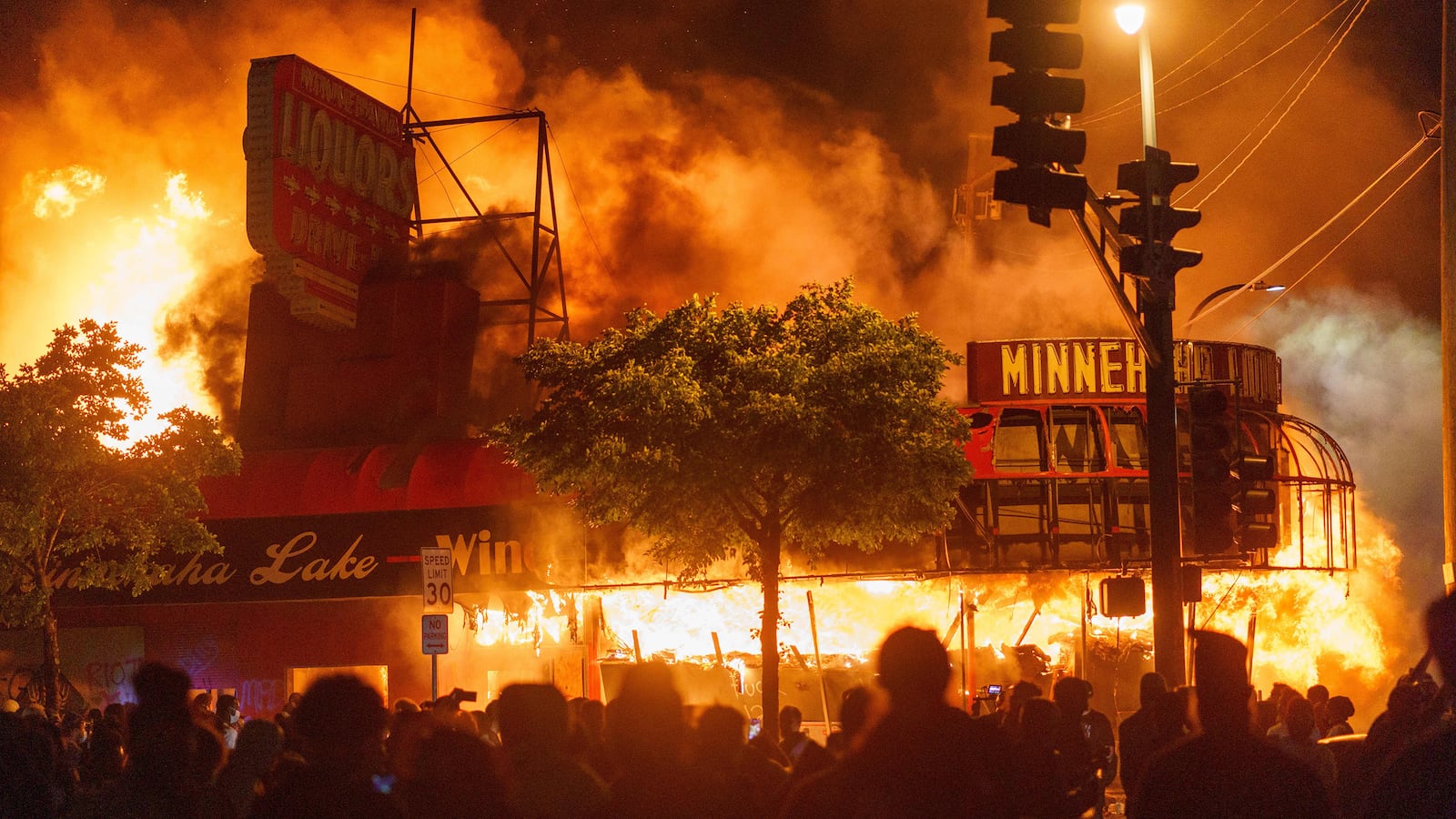No matter who you are, if you lived in the Twin Cities, chances are you experienced moments of abject terror after George Floyd got murdered and Minneapolis exploded last year.
Like the plywood still seen nailed over windows periodically about town, that fear has lasted. The unprecedented mayhem that followed one man’s death on May 25, 2020, has changed us. There have been some encouraging hints and signs of progress—and the guilty verdict in the Derek Chauvin murder case that was the bare minimum, sure. But people of color in the Twin Cities are still waiting to learn what the memory of last summer will really mean, what it will amount to.
I was born and raised in St. Paul, and live in Minneapolis, and hope to never see some of the things I saw a year ago ever again. Until last May 28, I had never been so close to a building on fire—a literal towering inferno that we used to call Minneapolis’ Third Precinct. At one point, while covering the peak of the chaos for The Daily Beast, I walked directly toward one spiral column of glorious flame, close enough that my eyes were seared and I momentarily struggled to see out of one of them.
I’d only ever seen such flames in movies or TV. I acted as though the fire was computer-generated, there for my amusement.
All of us standing there had watched as the Minneapolis police evacuated moments earlier. But then a group of officers circled back; I figured they must have had to grab something. Suddenly, I was sure they were going to try to take back the precinct. I was equally sure that would mean protesters getting killed. I found myself crying out a warning.
“Don’t do that, calm down,” a Black man reprimanded me as a coterie of activists and journalists made its way back to the precinct—and the arsonists made their way deeper into the abandoned police outpost. I was wrong. Massacre was avoided.
Police slaughtering people to stop the burning of a building may seem, even now, unthinkable. But an entire police precinct burning down in the first place, ignited by people who believed—who knew—the police had committed murder, was also impossible to imagine. So, even now, is the video of Floyd’s murder for many in the Twin Cities.
Last year, the seemingly unfathomable became routinized. It was not clear what would be there—what would be left—when it was all over.
I look around now and struggle with how different this city, with a deep history of police violence, really is. In the days following Floyd’s death, Minneapolis agreed to some quick fixes, banning police from using chokeholds and neck restraints. A majority of Minneapolis City Council members even vowed to abolish the police department. But part of that group eventually pivoted, and the charter commission voted against putting the question of dismantling the police on the ballot before city voters.
The proverbial white kid I went to class with who lives in South Minneapolis now seems more open to the idea that police treat Black people a certain way. But I’ve found in my reporting that even as everyone seems to have a white friend or neighbor suddenly willing to talk about race and policing, many in the city—and I mean many—still scoff at the notion of police being inherently racist.
Was the fear a good thing, then? Is such fear ever beneficial? My fear now is that Minneapolis’ scarring didn’t increase our sensitivity to claims of injustice, but simply hardened us against those who would dare to protest.
The same city that was caught off-guard at the rage sparked by the video of Floyd’s killing did much more to gird against another such outburst—and much less to prevent another person like Floyd senselessly dying at the hands of police. The reaction to the Floyd video seems to have tilted Derek Chauvin’s verdict to guilty on all counts, a punishment meant to prevent mass chaos from happening all over again. But the city’s government buildings and police precincts were also outfitted with security that resembled a foreign army base. I am way too accustomed to the sight of National Guard members hulking rifles for someone who lives in what was, until recently, a fairly normal American city.
We saw evidence of that disparity—the effort my community had made to fortify itself rather than make policing better for everyone—just north of Minneapolis, even before the verdict came down, when a white cop killed Daunte Wright in Brooklyn Center. There we were again, as a state and nation and world, glued to video out of the Twin Cities metro area of a white officer killing a Black man.
The main difference? The cops were ready this time, and protesters ate shit.
As a lifelong Minnesotan—even as a Black one—I found myself tempted by the myth of the state’s exceptionalism: We’re nice here. We fish at the lake here. Though I encounter racism every day because that’s what it means to be Black, and though my very identity means I’m painfully aware of the many histories of death and brutality that befall people descended from my continent, these icky themes of American life were not supposed to be present here. Pushing back against that—forcing myself and my peers to reckon with the reality—is endless and exhausting.
It’s safe to say everything won’t right itself, and the Twin Cities will never rise like some kind of phoenix from so much pain, death, and unrest. But that yea-sure-ya-betcha shock at the idea of Minnesotans being racist—or just being downright evil, along with the state’s institutions —is gone now. It’s largely burned away. We, collectively, know better.








